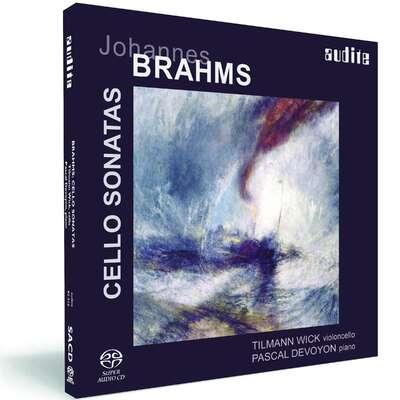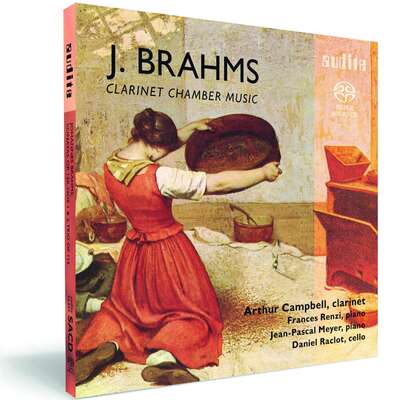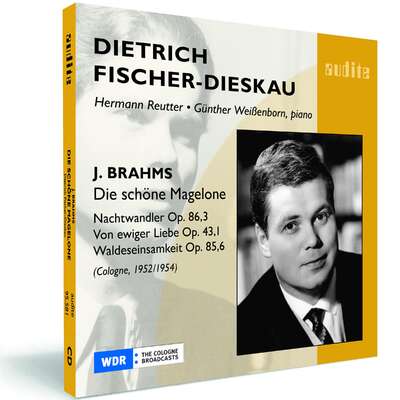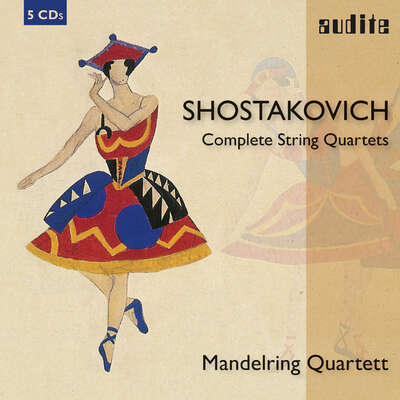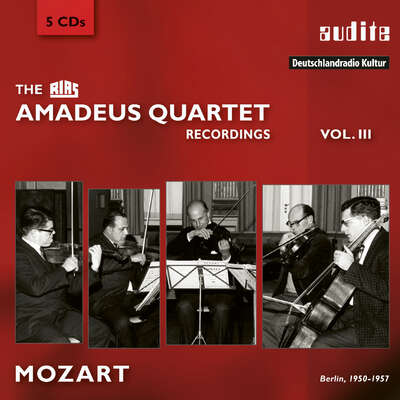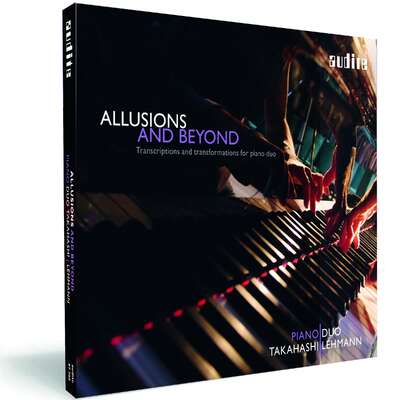
"Es ist eine lohnende und verdienstvolle Idee des Mandelrings Quartetts, Brahms und seine komponierenden Zeitgenossen einander gegenüberzustellen. Diese CD ist für Kammermusik-Freunde und -Fans auf jeden Fall ein Muss, zum einen, weil es Herzogenberg als kompetenten Komponisten zu entdecken und zu würdigen gilt, und es eben jenseits der "big-names" viel Qualität gibt, und zum anderen, weil es eine pure Freude ist, die ebenso analytisch-genau gearbeiteten wie liebe- und lustvoll und musikantisch präsentierten Interpretationen des Mandelring Quartetts zu hören." (NDR Kultur)
Details
| String Quartets by Brahms (Op. 67) & Herzogenberg (Op. 42, No.1) | |
| Artikelnummer: | 97.504 |
|---|---|
| EAN-Code: | 4022143975041 |
| Preisgruppe: | BCA |
| Veröffentlichungsdatum: | 11. Juli 2007 |
| Spielzeit: | 68 min. |
Zusatzmaterial
Besprechungen
classiqueinfo-disque.com | mardi 9 décembre 2008 | Vincent Haegele | 9. Dezember 2008 Brahms et quelques consorts
Brahms n’a pas été un compositeur de quatuors à cordes commeMehr lesen
American Record Guide | September/October 2008 | Bender | 1. September 2008
Both of these albums are devoted to the chamber music of Brahms (1833-97) and his contemporaries, and some readers may be surprised to see RichardMehr lesen
Heinrich von Herzogenberg (1843-1900) very much belonged to the Brahms circle. But he was reluctant to move on. The two works here – as with other of his music, but perhaps not the church music he devoted himself to more and more as he grew older – are instantly recognizable as Brahmsian. So history has done its best to forget them. That is too bad, because, especially if you favor idea over style, they are really lovely works. There is real expert mastery of the cello sonata and string quartet forms; they are melodically distinguished, and adroit in their avoidance of romantic excess. I am glad to add them my library.
If the film industry ever goes back to the kind of romantic drama favored before World War II, the triangle between Brahms and Herzogenberg and the latter's wife, Elisabeth, would make a fascinating movie. Matt Damon could star as Herzogenberg, Julia Roberts as Elisabeth, and Paul Giamatti as Brahms. Elisabeth was charming and musically talented and apparently a bit of a maneuverer; she regularly did her best to interest Brahms in her husband's music. Brahms, a confirmed bachelor, doted on her and did his best to comply, but seems to have been steadily growing weary of having Herzogenberg at his feet. Heinrich might have been better off for his career taking Elisabeth and moving elsewhere. He did eventually move to Berlin with her.
Meanwhile, the older composer was rolling on musically. In Germany's Mandelring Quartet he has an exciting new champion. It consists of the violist Roland Glassi and three Schmidts – Sebastian and Nanette on violins and Bernhard on cello. One has to assume the Schmidts are related; Audite is silent on the subject. The players are very good. The performance of Brahms's third and last quartet, in B-flat, Op. 67, is one of the finest to come along in years.
The Mandelring's Brahms benefits from judicious tempos, an imaginative dynamic range, clear textures, and careful blending. The performance of the Andante (II) is wonderfully expressive and secure in the way it captures the long lines of Brahms's writing. In the variations of IV the group displays a kaleidoscope of colors that they seem to use to help shape the phrasing. Their performance of the Herzogenberg quartet is filled with the kind of energy and belief that seems to say, "we delight in the discovery of this work".
Moser has won assorted prizes, and his resume lists performances with orchestras in the US, Britain, and Europe. Judging by this release, he plays excellently and with understanding. So does Rivinius, who gets one picture in the album as opposed to five dreamy poses accorded the cellist, who also offers a lofty interview rather pretentiously tided "The Sum of the Universe", Brahms apparently being the universe. Brahms's First Cello Sonata is a beautiful piece with an outstanding last movement that Moser and Rivinius set forth with flair, taste, and imagination. It is also nice to hear them plunge into that world-being-born inside Strauss's mind, and to note how they give equal attention to his small debts to Mendelssohn, Schumann, and Brahms, yet give rapt attention to Strauss's own genius, which would keep him moving on until half-way through the next century.
Fanfare | Issue 31:5 (May/June 2008) | Jerry Dubins | 1. Mai 2008
This is one of the other two companion discs mentioned in my review of Audite 97505 elsewhere. On three separate CDs—this one being Volume 2—theMehr lesen
On the present disc is a string quartet by Heinrich von Herzogenberg (1843–1900), an individual who enjoyed a special status within the Brahms circle, but for reasons other than his musical endowments. Elisabet von Stockhausen had been a piano pupil of Brahms, and she was to become possibly his most passionate love fixation, more so even than Clara Schumann. The letters they exchanged—some 250 of them—are filled with Brahms’s thinly veiled amorous yearnings.
Until 1868 marriage looked like it might be in the cards, but for reasons still not clear—cold feet?—Brahms broke off the relationship, and Elisabet married—guess who?—Heinrich von Herzogenberg. On one level, Brahms must have felt relieved, for he was now free to resume a Platonic relationship with Elisabet for whom he still had strong feelings. Being human, however, Brahms must have felt pangs of anger, betrayal, jealousy, and envy; yet in order to maintain good relations with Elisabet he had to suppress such feelings and remain civil, if not gracious, to the man who stole his sweetheart. To complicate matters further, Heinrich grew ever more idolatrous of Brahms, seeking his advice and mentorship, and attempting to mimic the elder composer’s style, all the while apparently oblivious to or unconcerned by Elisabet’s and Brahms’s relationship.
Of the many composers that circulated in Brahms’s sphere, Herzogenberg may have tried the hardest, without entirely succeeding, to imitate Brahms’s style. In a review of his solo piano works, (30:3) I wrote, “Unmistakably, this music was incubated in the Brahms-Schumann nursery, but just as unmistakably, it does not quite resemble either parent. Not as emotionally charged or lyrically expressive as Schumann, and not as introspective, psychologically complex, or harmonically and rhythmically advanced as Brahms, Herzogenberg seems nonetheless to have forged a derivative style based on his models, yet one that manages to avoid slavish aping.” And as far back as 25:2, Raymond Tuttle wrote of Herzogenberg’s E-Minor Piano Quartet, “From the opening notes, a Brahmsian wave washed over me...”.
Herzogenberg’s 1883 G-Minor String Quartet (the first of a set of three he wrote under the op. 42) is unabashedly Brahmsian. I would not argue with Tuttle on that point. I would not go so far as to say, however, that Herzogenberg was so determined a copyist—or strove to be—that his work could pass for the real McCoy. Brahms may have been the most imitated of all composers, yet his music resists exact imitation. One of the keys to understanding this is the subtle and secret art of “continuation.” The rules of harmony and counterpoint can be taught and learned. The gift of melody is, well, a gift. But having stated a musical idea, what follows it, what comes next, and why it takes your breath away or doesn’t is one of music’s enduring mysteries.
When you listen to the Brahms B♭ Quartet on this disc, you will hear a minimum of musical material that coalesces and expands into ever widening arcs. One by one, these jigsaw puzzle pieces fit together to form a work that satisfies on a deeper, subconscious level as a result of its organizational principles and structure.
Now listen to the Herzogenberg. Does it sound like Brahms? On the surface, yes, pretty much it does. But try listening below the surface, and what you are likely to discover is that it lacks the coherence and cohesion of the Brahms. On the surface, it’s a beautiful thing. Underneath, its progression of ideas is felt more than heard to be weak in the continuation that gives Brahms such underlying strength.
Audite is to be applauded for contrasting works by Brahms with those of his contemporaries and friends on the same discs; for in this way we can hear for ourselves the differences, sometimes subtle, other times not, between these composers that were drawn in by and circled like lesser satellites around the most influential composer of the late 19th century.
I am more positively disposed towards the Mandelring’s reading of Brahms’s B♭-Major Quartet on this volume than I was towards their less energized interpretation of the A-Minor Quartet on Volume 3. The B♭-Major is an altogether less intense, less tightly wound work, and the Mandelring’s more easygoing manner suits it perfectly. Listen to their amiable way with the last movement. If your interest is strictly in the Brahms, however, I’d still put my money on the Emerson Quartet.
As for the Herzogenberg, there don’t seem to be any alternative versions to choose from at the moment, which is all the more reason to be grateful for the Mandelring’s recording, which is excellent in all respects. Recommended.
CD Compact | Número 218, Marzo 2008 | Emili Blasco | 1. März 2008
Audite presenta dos discos con el Cuarteto Manderling como protagonistaMehr lesen
Muzyka21 | 1 (90) – styczeń 2008 | Stanisław Lubliński | 1. Januar 2008
Prezentowane trzy nagrania stanowiące jeden cykl powinny mieæ wspólnyMehr lesen
Classica-Répertoire | décembre 2007-janvier 2008 | Antoine Mignon | 1. Dezember 2007
Les Mandelring poursuivent leur exploration des quatuors à cordes deMehr lesen
Fono Forum | 11/2007 | Marcus Stäbler | 1. November 2007 Zeitgenossen, Schüler und Lehrer
In einer verdienstvollen CD-Reihe kombiniert das Label Audite Werke von Brahms mit Ersteinspielungen von Quartetten seiner Zeitgenossen, die ihnMehr lesen
Im direkten Vergleich bleibt der Schüler indes doch ein wenig hinter dem Standard seines Lehrers zurück: Herzogenbergs g-Moll-Quartett op. 42 Nr. 1 aus dem Jahr 1883 vermag zwar insbesondere mit den rhythmischen Raffinessen im dritten Satz durchaus zu gefallen, kann jedoch mit der motivischen Dichte und dem ungleich größeren thematischen Einfallsreichtum des fünf Jahre älteren Quartetts op. 7 von Dessoff nicht mithalten, das von souveräner handwerklicher Meisterschaft zeugt.
An die Werke ihres omnipräsenten Vorbildes und Freundes Brahms können allerdings beide Komponisten nicht wirklich heranreichen. Obwohl sie seinen Modellen keinesfalls sklavisch folgen, bleibt ihnen eine vergleichbare Eigenständigkeit, melodische Prägnanz und formale Dichte doch verwehrt. Gleichwohl sind die Einspielungen als interessante und reizvolle, stellenweise sogar durchaus fesselnde Repertoire-Bereicherungen hochwillkommen – zumal sie in den Mitgliedern des Mandelring-Quartetts ebenso kompetente wie engagierte Anwälte gefunden haben, die einmal mehr das vorzügliche Niveau des Ensembles unter Beweis stellen.
Neue Musikzeitung | nmz 2007/11 | Seite 42 | 56. Jahrgang | November | Hanspeter Krellmann | 1. November 2007 Zeitgenossenschaft
Generations-Angehörige innerhalb einer Epoche bilden, auch wenn sie ohneMehr lesen
Le Monde de la Musique | Novembre 2007 | Patrick Szersnovicz | 1. November 2007
Si Brahms n'a abordé le quatuor à cordes qu'après un par-cours long et détourné, l'alchimie thématique et l'interférence des rythmes binairesMehr lesen
Excellente jeune formation allemande, le Quatuor Mandelring poursuit son intégrale en couplant chaque fois un quatuor de Brahms avec un quatuor d'un de ses contemporains. Sans éclipser les sommets de la discographie (Quatuors Juilliard. Amadeus, Alban Berg, Prazak), son interprétation du Troisième Quatuor en si bémol majeur est une fort belle réussite, où la maîtrise technique et le sens de l'architecture, assez proche de celui du Quatuor de Leipzig, se marient à une acuité intellectuelle qui s'inscrit dans une tout autre filiation – celle du Quatuor LaSalle –, a priori très éloignée de la tradition germanique. Le rythme est aussi tendu, les voix internes aussi équilibrées dans une lecture du Quatuor op 42 n° 1 de Herzogenberg qui parvient presque à réhabiliter l'œuvre.
RBB Kulturradio | Kulturrradio am Mittag | Cornelia Schönberg | 23. Oktober 2007
Das deutsche Mandelring Quartett widmet sich seit einiger Zeit weniger gespielten Streichquartett-Werken und ermöglicht damit interessanteMehr lesen
Dessoff und Herzogenberg sind Musikerpersönlichkeiten aus dem unmittelbaren Umkreis von Brahms. Dessoff, etwa gleichaltrig, verbuchte vor allem als Dirigent große Erfolge, Brahms schätzte den Kollegen. Herzogenberg dagegen war zehn Jahre jünger und konnte als Komponist nur freundliche Zurückhaltung von Brahms ernten.
Es sind kleine, aber in der Summe wesentliche Details, die die Brahms-Quartette von den recht ähnlich klingenden Werken Dessoffs und Herzogenbergs unterscheiden. Brahms war eben doch der originellere, spannungsreichere, perfektere Komponist. Doch zu dieser Erkenntnis mischt sich beim Hören Anerkennung über die erstaunliche Qualität der unbekannten Streichquartettwerke, denen man eine häufigere Aufführung wünscht.
Das Mandelring Quartett spielt tonschön, gut ausbalanciert und mit sauberer Intonation. Der Einsatz des Ensembles ist sehr verdienstvoll, denn Brahms steht nicht einsam auf seinem Sockel in einer musikalischen Wüste: der Komponist lebte in einem genauso turbulent-vielschichtigen klanglichen Umfeld wie wir heute.
Ensemble - Magazin für Kammermusik | Oktober/November 2007 | Helmut Peters | 1. Oktober 2007 Doppelliebe
Die Serie „Brahms und Zeitgenossen“, die das Mandelring Quartett fürMehr lesen
Diverdi Magazin | N° 163 / octubre 2007 | Blas Matamoro | 1. Oktober 2007
Brahms y el brahmsismo
Desoff y Herzogenherg, enfrentados a su gran contemporáneo hamburgués
Brahms, aparte de ser uno de los grandes, suele emblematizar al conservatismo estético. Frente a Wagner, doctrinal, revolucionario y anunciador de unMehr lesen
Hoy podemos deshacer el tópico brahmsiano. Si bien don Hans se valió de estructuras heredadas y consolidadas, no lo hizo en plan reminiscente sino añadiendo elementos inéditos, renovando el legado a su manera. Así se lo reconoció nada menos que Arnold Schönberg y al tema dedicó un minucioso y bello libro Massimo Mila. La polémica sigue abierta, pues ¿hasta qué punto no conservó la dodecafonía el semitono, la escritura pentagramática y la orquestación de toda la vida?
Estos compactos nos ofrecen un curioso y necesario paralelo entre cuartetos de Brahms y de dos "brahmsistas" contemporáneos. En el caso de Heinrich von Herzogenberg, a su devoción se une la de su mujer Elisabeth, que se escribió con Brahms unas 250 cartas de amistad encendida, ruegos y partituras dedicadas. A Brahms le atraían las mujeres de sus amigos, como Clara Schumann. Dejémonos de freudismos.
En cuanto a Félix Otto Desoff, mucho menos recordado que el anterior, se trata de un director de orquesta y pianista muy cercano a la carrera del compositor magistral. Redactando música se consideró siempre una suerte de alumno preferido. O sea que, en ambos casos, estamos ante una suerte de círculo de trabajo y afecto que redunda en el ejercicio de un lenguaje común. Ni Herzogenberg ni Desoff fueron Brahms, pero quisieron ser como él y lograron enriquecer el mundo brahmsiano. Al lado del modelo no empalidecen ni piden disculpas. Inventan, escriben, corrigen y he aquí las pruebas de una admiración estimulante.
Musica | Nr. 190 (ottobre 2007) | 1. Oktober 2007
Heinrich von Herzogenberg fu amico di Johannes Brahms (che era più vecchioMehr lesen
Die Welt | Freitag, 7. September 2007 | Helmut Peters | 7. September 2007 Inspiriert durch Johannes Brahms
Die Freundschaft zwischen Mann und Frau, spekulierte der französischeMehr lesen
NDR Kultur | 1. August 2007, 15.30 Uhr | Elisabeth Richter | 1. August 2007 Hohe Qualität abseits der "big names"
Das Mandelring Quartett ist seit dem Gewinn des ARD-Wettbewerbs in München und weiterer bedeutender Kammermusik-Wettbewerbe eines der herausragendenMehr lesen
Man spürt es von der ersten Note an: Heinrich von Herzogenberg war ein unruhiger Geist, der aber auszudrücken wusste, was er sagen wollte. Dabei kommt auch ein zarter und verinnerlichter Ton nicht zu kurz, wie im Quartett g-moll op. 42. Herzogenberg verstand sein Handwerk, und vermutlich hätte er es nicht nötig gehabt, den zehn Jahre älteren Freund und Kollegen Johannes Brahms über alle Maßen zu bewundern: "Der Gedanke an ihn", schrieb Herzogenberg, "und sein Urtheil hat aus mir gemacht soviel eben wurde; er war mein Fleiß, mein Ehrgeiz, mein Muth".
Brahms B-Dur Quartett op. 67 spielt das Mandelring Quartett ebenso transparent, und klar konturiert, mit warmem, homogenem Klang und spannungsreicher Dynamik wie das Herzogenberg-Quartett. Es ist eine lohnende und verdienstvolle Idee des Mandelrings Quartetts, Brahms und seine komponierenden Zeitgenossen einander gegenüberzustellen: Wie schon der in Volume 1 präsentierte Friedrich Gernsheim, so schneidet auch Herzogenberg ziemlich gut ab. Der wild düstere Kopfsatz steht Brahms in nichts nach. Allenfalls in der Gesamt-Architektur, in der großen Form ist Brahms vielleicht überlegen. Herzogenbergs Quartett steckt voller charmanter Einfälle, rhythmischer Vertracktheiten oder Reminiszenzen an alte Formen.
Diese CD ist für Kammermusik-Freunde und -Fans auf jeden Fall ein Muss, zum einen, weil es Herzogenberg als kompetenten Komponisten zu entdecken und zu würdigen gilt, und es eben jenseits der "big-names" viel Qualität gibt, und zum anderen, weil es eine pure Freude ist, die ebenso analytisch-genau gearbeiteten wie liebe- und lustvoll und musikantisch präsentierten Interpretationen des Mandelring Quartetts zu hören.
Neuigkeiten
This is one of the other two companion discs mentioned in my review of Audite...
Heinrich von Herzogenberg fu amico di Johannes Brahms (che era più vecchio di...
Both of these albums are devoted to the chamber music of Brahms (1833-97) and...
Audite presenta dos discos con el Cuarteto Manderling como protagonista...
Si Brahms n'a abordé le quatuor à cordes qu'après un par-cours long et...
Prezentowane trzy nagrania stanowiące jeden cykl powinny mieæ wspólny tytuł...
Les Mandelring poursuivent leur exploration des quatuors à cordes de Brahms...
Das deutsche Mandelring Quartett widmet sich seit einiger Zeit weniger...


























